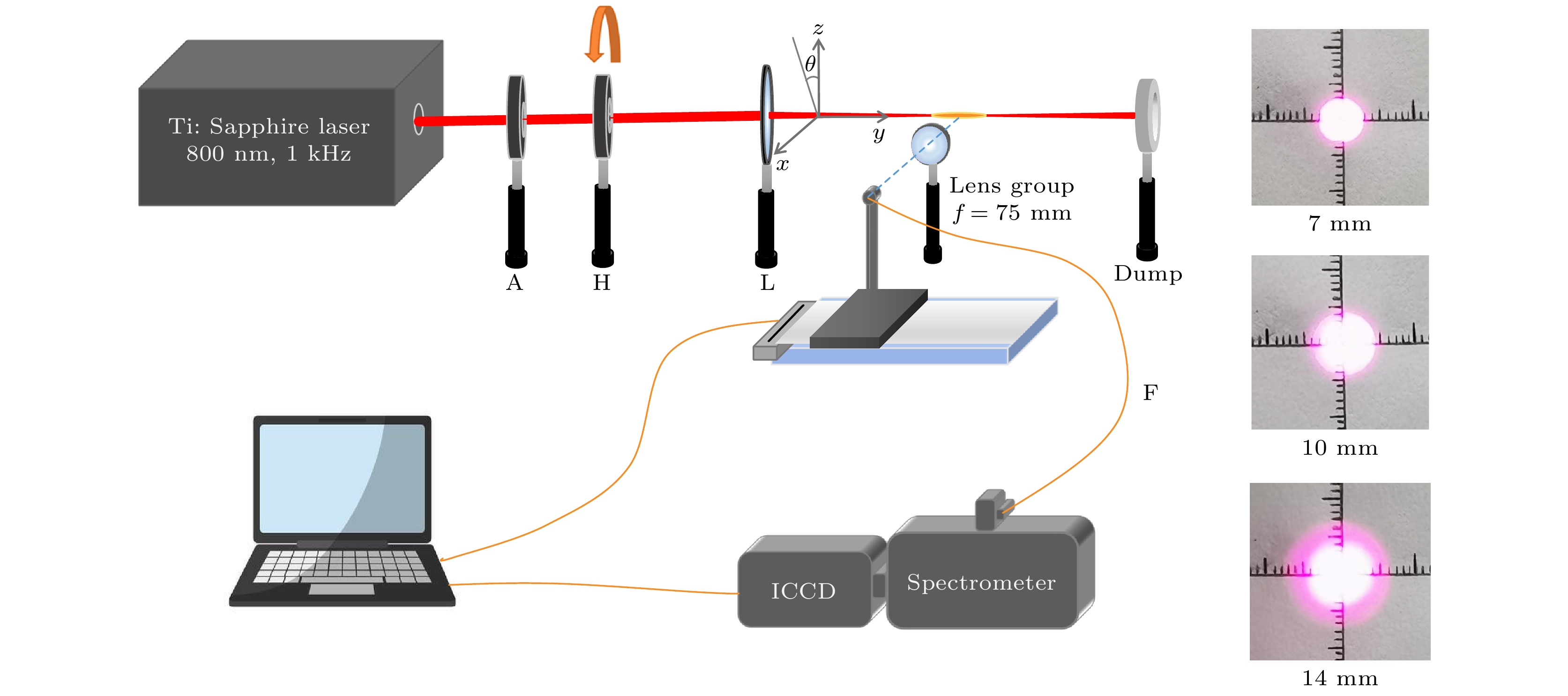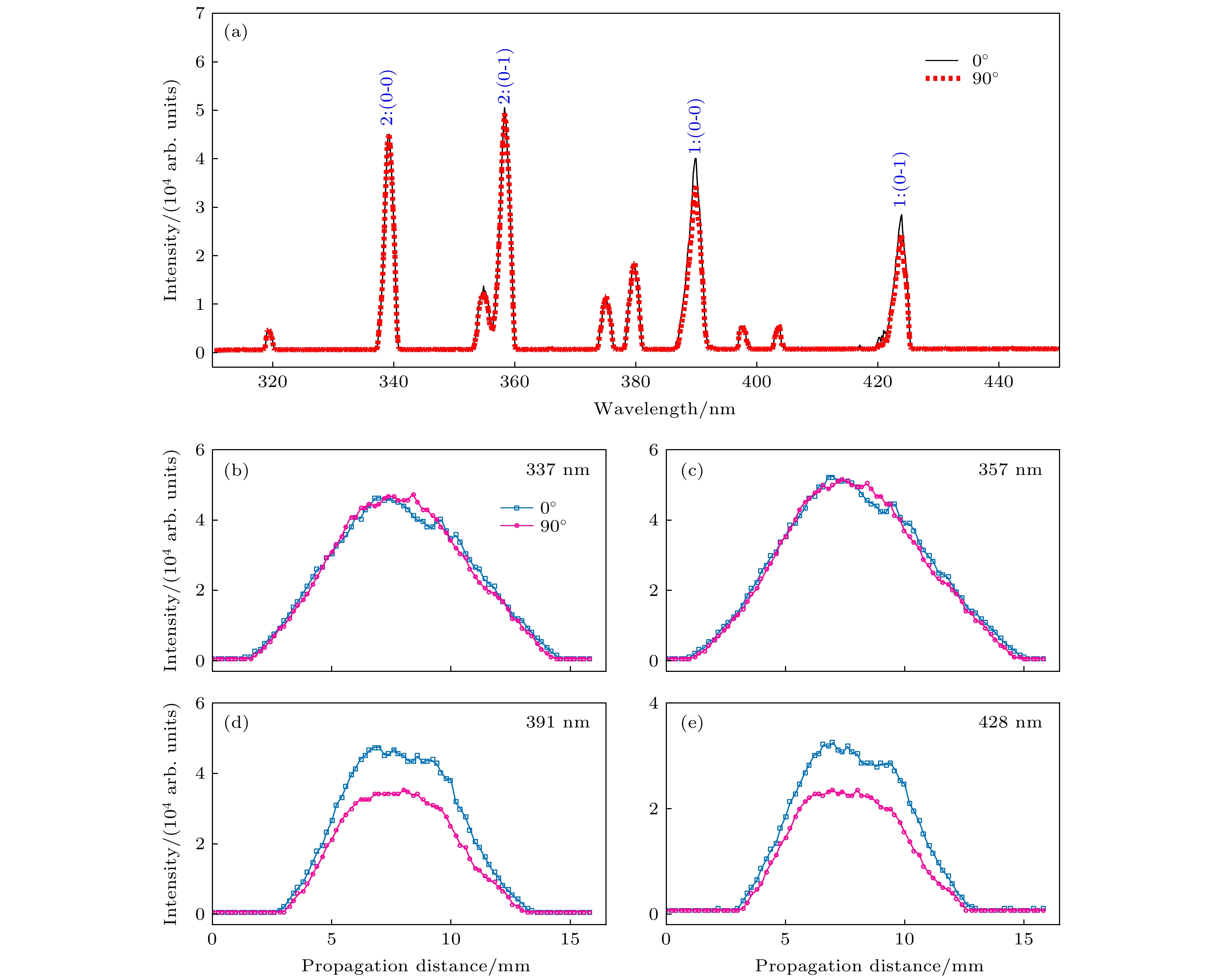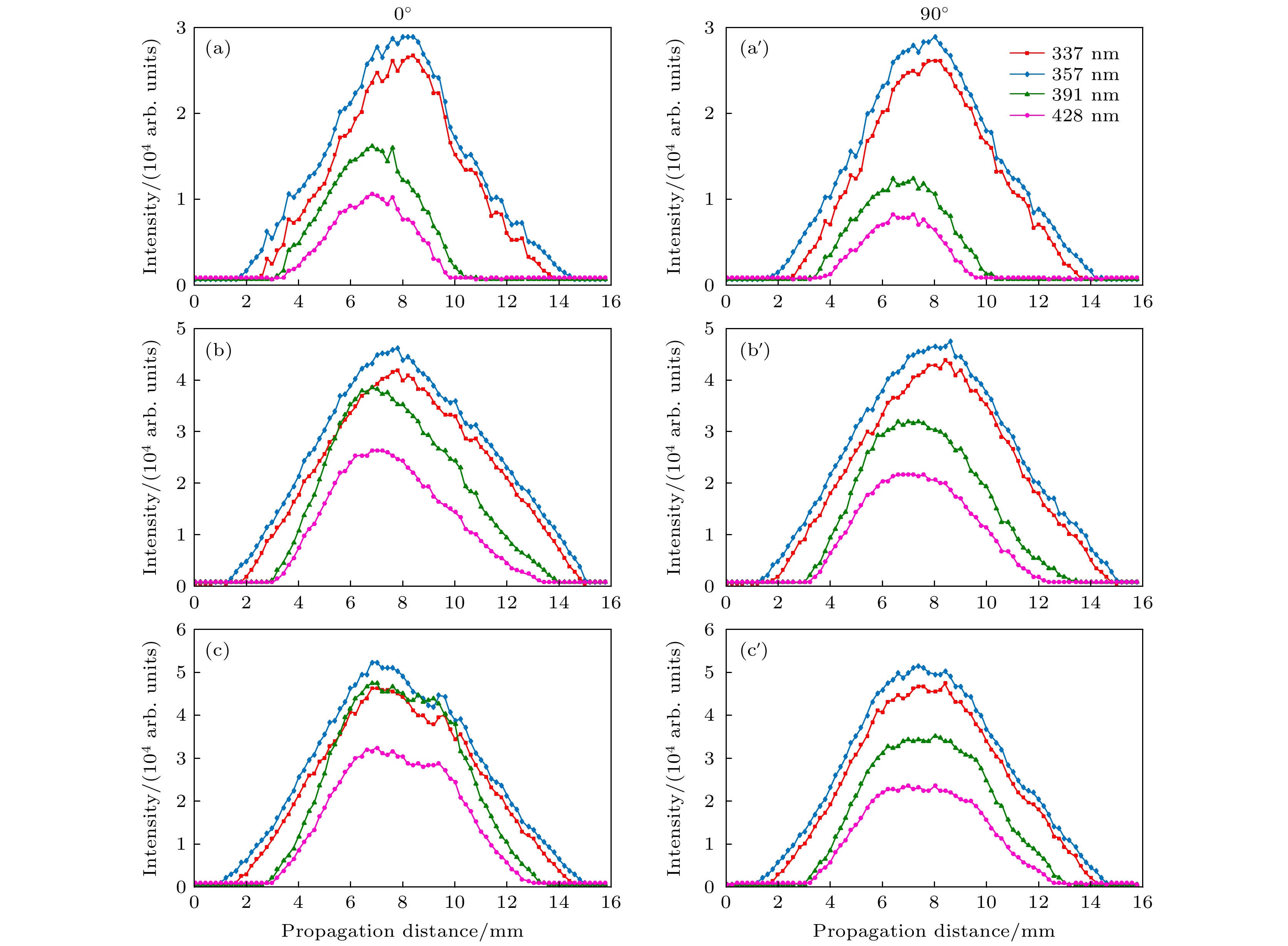-
As a major component in the air, nitrogen emits fluorescence when it interacts with intensive laser field. The fluorescence comes from the first negative band system (
${{\rm{B}}^{{2}}}\Sigma _{\rm{u}}^{{ + }} \to {{\rm{X}}^{{2}}}\Sigma _{\rm{g}}^{{ + }}$ transition) of${\rm{N}}_{{2}}^{{ + }}$ and the second positive band system (${{\rm{C}}^{{3}}}\Pi _{\rm{u}}^{{ + }} \to {{\rm{B}}^{{3}}}\Pi _{\rm{g}}^{{ + }}$ transition) of${{\rm{N}}_{{2}}}$ . Under the action of high-intensity femtosecond laser,${{\rm{N}}_{{2}}}$ can be directly photo-ionized into${\rm{N}}_{{2}}^{{ + }}{{(}}{{\rm{B}}^{{2}}}\Sigma _{\rm{u}}^{{ + }})$ , which results in fluorescence emission of${\rm{N}}_{{2}}^{{ + }}$ . In the process of femtosecond laser filament formation, the dynamic processes such as ionization and excitation of nitrogen molecules are affected by the laser intensity distribution and laser polarization direction. The products show different distributions in the propagation direction and radial space, which, in turn, affects its light emission. Therefore, it is necessary to further ascertain its generation mechanism through the spatial distribution of nitrogen fluorescence. In this experiment, the spatial distribution of the nitrogen fluorescence emission generated by linearly polarized femtosecond laser pulse filaments in air is measured. By changing the polarization direction of the laser to study the distribution of nitrogen fluorescence in the radial plane, it is found that the fluorescence emission of${\rm{N}}_2^ + $ is more intense in the direction perpendicular to the laser polarization, while it is weaker in the direction parallel to the laser polarization. The nitrogen fluorescence emission has the same intensity in all directions. The ionization probability of a linear molecule depends on the angle between the laser polarization direction and the molecular axis, which is maximum (minimum) when the angle is${{{0}}^{\rm{o}}}$ (${{9}}{{{0}}^{\rm{o}}}$ ). The${{\rm{N}}_{{2}}}$ gas is more likely to be ionized in the laser polarization direction, the nitrogen molecular ions${\rm{N}}_{{2}}^{{ + }}$ and electrons are separated in the direction parallel to the laser polarization. Therefore, more ions (${\rm{N}}_{{2}}^{{ + }}$ ) are generated in the direction parallel to the laser polarization, and the fluorescence emission of${\rm{N}}_{{2}}^{{ + }}$ is more intense. Along the propagation direction of the laser, it is found that the fluorescence of${{\rm{N}}_{{2}}}$ appears before the fluorescence of${\rm{N}}_2^ + $ and disappears after the fluorescence of${\rm{N}}_{{2}}^{{ + }}$ has vanished. This is due to the fact that${{\rm{N}}_{{2}}}$ can be ionized into${\rm{N}}_{{2}}^{{ + }}{{(}}{{\rm{B}}^{{2}}}\Sigma_{\rm{u}}^{{ + }})$ at the position of high enough laser intensity, thus emitting fluorescence of${\rm{N}}_2^ + $ . However, the laser energy is not enough to ionize nitrogen at the beginning and end of laser transmission, but it can generate${\rm{N}}_2^ * $ , which emits nitrogen fluorescence through the process of intersystem crossing${\rm{N}}_2^*\xrightarrow{{{\rm{ISC}}}}{{\rm{N}}_2}({{\rm{C}}^3}\Pi _{\rm{u}}^ + )$ . The spatial distribution of nitrogen fluorescence emission during femtosecond laser filament formation shows that in the case of short focal length, the intersystem crossing scheme can explain the formation of${{\rm{N}}_{{2}}}{{(}}{{\rm{C}}^{{3}}}\Pi _{\rm{u}}^{{ + }})$ . This research is helpful in understanding the mechanism of nitrogen fluorescence emission.[1] Xu H, Cheng Y, Chin S L, Sun H B 2015 Laser Photonics Rev. 9 275
 Google Scholar
Google Scholar
[2] Dicaire I, Jukna V, Praz C, Milián C, Summerer L, Couairon A 2016 Laser Photonics Rev. 10 481
 Google Scholar
Google Scholar
[3] Lange H R, Chiron A, Ripoche J F, Mysyrowicz A, Breger P, Agostini P 1998 Phys. Rev. Lett. 81 1611
 Google Scholar
Google Scholar
[4] Kasparian J, Sauerbrey R, Chin S L 2000 Appl. Phys. B 71 877
 Google Scholar
Google Scholar
[5] Li S, Chen A, Jiang Y, Jin M 2018 Opt. Commun. 426 105
 Google Scholar
Google Scholar
[6] Chin S L, Xu H L, Luo Q, Théberge F, Liu W, Daigle J F, Kamali Y, Simard P T, Bernhardt J, Hosseini S A, Sharifi M, Méjean G, Azarm A, Marceau C, Kosareva O, Kandidov V P, Aközbek N, Becker A, Roy G, Mathieu P, Simard J R, Châteauneuf M, Dubois J 2009 Appl. Phys. B 95 1
 Google Scholar
Google Scholar
[7] Xu S, Sun X, Zeng B, Chu W, Zhao J, Liu W, Cheng Y, Xu Z, Chin S L 2012 Opt. Express 20 299
 Google Scholar
Google Scholar
[8] Sun X, Xu S, Zhao J, Liu W, Cheng Y, Xu Z, Chin S L, Mu G 2012 Opt. Express 20 4790
 Google Scholar
Google Scholar
[9] Hosseini S A, Luo Q, Ferland B, Liu W, Aközbek N, Roy G, Chin S L 2003 Appl. Phys. B 77 697
 Google Scholar
Google Scholar
[10] Daigle J F, Jaroń-Becker A, Hosseini S, Wang T J, Kamali Y, Roy G, Becker A, Chin S L 2010 Phys. Rev. A 82 023405
 Google Scholar
Google Scholar
[11] Lei M, Wu C, Liang Q, Zhang A, Li Y, Cheng Q, Wang S, Yang H, Gong Q, Jiang H 2017 J. Phys. B: At. Mol. Opt. Phys. 50 145101
 Google Scholar
Google Scholar
[12] Ran P, Li G, Liu T, Hou H, Luo S 2019 Opt. Express 27 19177
 Google Scholar
Google Scholar
[13] Wang P, Xu S, Li D, Yang H, Jiang H, Gong Q, Wu C 2014 Phys. Rev. A 90 033407
 Google Scholar
Google Scholar
[14] 朱竹青, 王晓雷 2011 物理学报 60 085205
 Google Scholar
Google Scholar
Zhu Z Q, Wang X L 2011 Acta Phys. Sin. 60 085205
 Google Scholar
Google Scholar
[15] Wu J, Wu Z, Chen T, Zhang H, Zhang Y, Zhang Y, Lin S, Cai X, Chen A, Jiang Y, Li S, Jin M 2020 Opt. Laser Technol. 131 106417
 Google Scholar
Google Scholar
[16] Mitryukovskiy S, Liu Y, Ding P, Houard A, Couairon A, Mysyrowicz A 2015 Phys. Rev. Lett. 114 063003
 Google Scholar
Google Scholar
[17] Xu H L, Azarm A, Bernhardt J, Kamali Y, Chin S L 2009 Chem. Phys. 360 171
 Google Scholar
Google Scholar
[18] Arnold B R, Roberson S D, Pellegrino P M 2012 Chem. Phys. 405 9
 Google Scholar
Google Scholar
[19] Li S, Jiang Y, Chen A, He L, Liu D, Jin M 2017 Phys. Plasmas 24 033111
 Google Scholar
Google Scholar
[20] Becker A, Bandrauk A D, Chin S L 2001 Chem. Phys. Lett. 343 345
 Google Scholar
Google Scholar
[21] Li S, Sui L, Chen A, Jiang Y, Liu D, Shi Z, Jin M 2016 Phys. Plasmas 23 023102
 Google Scholar
Google Scholar
[22] Su Q, Sun L, Chu C, Zhang Z, Zhang N, Lin L, Zeng Z, Kosareva O, Liu W, Chin S L 2020 J. Phys. Chem. Lett. 11 730
 Google Scholar
Google Scholar
[23] Pavičić D, Lee K F, Rayner D M, Corkum P B, Villeneuve D M 2007 Phys. Rev. Lett. 98 243001
 Google Scholar
Google Scholar
[24] 姚云华, 卢晨晖, 徐淑武, 丁晶新, 贾天卿, 张诗按, 孙真荣 2014 物理学报 63 184201
 Google Scholar
Google Scholar
Yao Y H, Lu C H, Xu S W, Ding J X, Jia T Q, Zhang S A, Sun Z R 2014 Acta Phys. Sin. 63 184201
 Google Scholar
Google Scholar
[25] Itikawa Y 2006 J. Phys. Chem. Ref. Data 35 31
 Google Scholar
Google Scholar
[26] Liu Y, Ding P, Lambert G, Houard A, Tikhonchuk V, Mysyrowicz A 2015 Phys. Rev. Lett. 115 133203
 Google Scholar
Google Scholar
[27] Chin S L, Xu H L, Cheng Y, Xu Z, Yamanouchi K 2013 Chin. Opt. Lett. 11 013201
 Google Scholar
Google Scholar
[28] Zhang Y, Lötstedt E, Yamanouchi K 2017 J. Phys. B: At. Mol. Opt. Phys. 50 185603
 Google Scholar
Google Scholar
[29] Xu H L, Lötstedt E, Iwasaki A, Yamanouchi K 2015 Nat. Commun. 6 8347
 Google Scholar
Google Scholar
[30] Ando T, Lötstedt E, Iwasaki A, Li H, Fu Y, Wang S, Xu H L, Yamanouchi K 2019 Phys. Rev. Lett. 123 203201
 Google Scholar
Google Scholar
[31] Yao J, Jiang S, Chu W, Zeng B, Wu C, Lu R, Li Z, Xie H, Li G, Yu C, Wang Z H, Jiang H, Gong Q, Cheng Y 2016 Phys. Rev. Lett. 116 143007
 Google Scholar
Google Scholar
[32] Bernhardt J, Liu W, Théberge F, Xu H L, Daigle J F, Châteauneuf M, Dubois J, Chin S L 2008 Opt. Commun. 281 1268
 Google Scholar
Google Scholar
[33] Plenge J, Wirsing A, Raschpichler C, Meyer M, Rühl E 2009 J. Chem. Phys. 130 244313
 Google Scholar
Google Scholar
-
图 3 (a)激光偏振方向平行(黑色实线)和垂直(红色虚线)于z轴时的氮荧光光谱; 激光偏振方向平行和垂直于z轴时(b) 337, (c) 357, (d) 391和(e) 428 nm荧光信号随传播距离的变化
Figure 3. (a) Nitrogen fluorescence spectrum when the laser polarization direction is parallel (solid black line) and perpendicular (dashed red line) to the z-axis. Variations of the (b) 337, (c) 357, (d) 391 and (e) 428 nm fluorescence signals with the propagation distance when the laser polarization direction is parallel and perpendicular to z-axis.
图 4 当脉冲能量为2.00, 2.63和3.00 mJ时, 激光偏振方向平行 (a), (b), (c)和垂直(a'), (b'), (c')于z轴时
${{\rm{N}}_{\rm{2}}}$ 和${\rm{N}}_{\rm{2}}^{{ + }}$ 荧光信号随传播距离的变化Figure 4. Variations of the
${{\rm{N}}_{\rm{2}}}$ and${\rm{N}}_{\rm{2}}^{{ + }}$ fluorescence signal with the propagation distance when the laser polarization direction is parallel (a), (b), (c) and perpendicular (a'), (b'), (c') to the z-axis and the pulse energy is 2.00, 2.63 and 3.00 mJ. -
[1] Xu H, Cheng Y, Chin S L, Sun H B 2015 Laser Photonics Rev. 9 275
 Google Scholar
Google Scholar
[2] Dicaire I, Jukna V, Praz C, Milián C, Summerer L, Couairon A 2016 Laser Photonics Rev. 10 481
 Google Scholar
Google Scholar
[3] Lange H R, Chiron A, Ripoche J F, Mysyrowicz A, Breger P, Agostini P 1998 Phys. Rev. Lett. 81 1611
 Google Scholar
Google Scholar
[4] Kasparian J, Sauerbrey R, Chin S L 2000 Appl. Phys. B 71 877
 Google Scholar
Google Scholar
[5] Li S, Chen A, Jiang Y, Jin M 2018 Opt. Commun. 426 105
 Google Scholar
Google Scholar
[6] Chin S L, Xu H L, Luo Q, Théberge F, Liu W, Daigle J F, Kamali Y, Simard P T, Bernhardt J, Hosseini S A, Sharifi M, Méjean G, Azarm A, Marceau C, Kosareva O, Kandidov V P, Aközbek N, Becker A, Roy G, Mathieu P, Simard J R, Châteauneuf M, Dubois J 2009 Appl. Phys. B 95 1
 Google Scholar
Google Scholar
[7] Xu S, Sun X, Zeng B, Chu W, Zhao J, Liu W, Cheng Y, Xu Z, Chin S L 2012 Opt. Express 20 299
 Google Scholar
Google Scholar
[8] Sun X, Xu S, Zhao J, Liu W, Cheng Y, Xu Z, Chin S L, Mu G 2012 Opt. Express 20 4790
 Google Scholar
Google Scholar
[9] Hosseini S A, Luo Q, Ferland B, Liu W, Aközbek N, Roy G, Chin S L 2003 Appl. Phys. B 77 697
 Google Scholar
Google Scholar
[10] Daigle J F, Jaroń-Becker A, Hosseini S, Wang T J, Kamali Y, Roy G, Becker A, Chin S L 2010 Phys. Rev. A 82 023405
 Google Scholar
Google Scholar
[11] Lei M, Wu C, Liang Q, Zhang A, Li Y, Cheng Q, Wang S, Yang H, Gong Q, Jiang H 2017 J. Phys. B: At. Mol. Opt. Phys. 50 145101
 Google Scholar
Google Scholar
[12] Ran P, Li G, Liu T, Hou H, Luo S 2019 Opt. Express 27 19177
 Google Scholar
Google Scholar
[13] Wang P, Xu S, Li D, Yang H, Jiang H, Gong Q, Wu C 2014 Phys. Rev. A 90 033407
 Google Scholar
Google Scholar
[14] 朱竹青, 王晓雷 2011 物理学报 60 085205
 Google Scholar
Google Scholar
Zhu Z Q, Wang X L 2011 Acta Phys. Sin. 60 085205
 Google Scholar
Google Scholar
[15] Wu J, Wu Z, Chen T, Zhang H, Zhang Y, Zhang Y, Lin S, Cai X, Chen A, Jiang Y, Li S, Jin M 2020 Opt. Laser Technol. 131 106417
 Google Scholar
Google Scholar
[16] Mitryukovskiy S, Liu Y, Ding P, Houard A, Couairon A, Mysyrowicz A 2015 Phys. Rev. Lett. 114 063003
 Google Scholar
Google Scholar
[17] Xu H L, Azarm A, Bernhardt J, Kamali Y, Chin S L 2009 Chem. Phys. 360 171
 Google Scholar
Google Scholar
[18] Arnold B R, Roberson S D, Pellegrino P M 2012 Chem. Phys. 405 9
 Google Scholar
Google Scholar
[19] Li S, Jiang Y, Chen A, He L, Liu D, Jin M 2017 Phys. Plasmas 24 033111
 Google Scholar
Google Scholar
[20] Becker A, Bandrauk A D, Chin S L 2001 Chem. Phys. Lett. 343 345
 Google Scholar
Google Scholar
[21] Li S, Sui L, Chen A, Jiang Y, Liu D, Shi Z, Jin M 2016 Phys. Plasmas 23 023102
 Google Scholar
Google Scholar
[22] Su Q, Sun L, Chu C, Zhang Z, Zhang N, Lin L, Zeng Z, Kosareva O, Liu W, Chin S L 2020 J. Phys. Chem. Lett. 11 730
 Google Scholar
Google Scholar
[23] Pavičić D, Lee K F, Rayner D M, Corkum P B, Villeneuve D M 2007 Phys. Rev. Lett. 98 243001
 Google Scholar
Google Scholar
[24] 姚云华, 卢晨晖, 徐淑武, 丁晶新, 贾天卿, 张诗按, 孙真荣 2014 物理学报 63 184201
 Google Scholar
Google Scholar
Yao Y H, Lu C H, Xu S W, Ding J X, Jia T Q, Zhang S A, Sun Z R 2014 Acta Phys. Sin. 63 184201
 Google Scholar
Google Scholar
[25] Itikawa Y 2006 J. Phys. Chem. Ref. Data 35 31
 Google Scholar
Google Scholar
[26] Liu Y, Ding P, Lambert G, Houard A, Tikhonchuk V, Mysyrowicz A 2015 Phys. Rev. Lett. 115 133203
 Google Scholar
Google Scholar
[27] Chin S L, Xu H L, Cheng Y, Xu Z, Yamanouchi K 2013 Chin. Opt. Lett. 11 013201
 Google Scholar
Google Scholar
[28] Zhang Y, Lötstedt E, Yamanouchi K 2017 J. Phys. B: At. Mol. Opt. Phys. 50 185603
 Google Scholar
Google Scholar
[29] Xu H L, Lötstedt E, Iwasaki A, Yamanouchi K 2015 Nat. Commun. 6 8347
 Google Scholar
Google Scholar
[30] Ando T, Lötstedt E, Iwasaki A, Li H, Fu Y, Wang S, Xu H L, Yamanouchi K 2019 Phys. Rev. Lett. 123 203201
 Google Scholar
Google Scholar
[31] Yao J, Jiang S, Chu W, Zeng B, Wu C, Lu R, Li Z, Xie H, Li G, Yu C, Wang Z H, Jiang H, Gong Q, Cheng Y 2016 Phys. Rev. Lett. 116 143007
 Google Scholar
Google Scholar
[32] Bernhardt J, Liu W, Théberge F, Xu H L, Daigle J F, Châteauneuf M, Dubois J, Chin S L 2008 Opt. Commun. 281 1268
 Google Scholar
Google Scholar
[33] Plenge J, Wirsing A, Raschpichler C, Meyer M, Rühl E 2009 J. Chem. Phys. 130 244313
 Google Scholar
Google Scholar
Catalog
Metrics
- Abstract views: 7612
- PDF Downloads: 148
- Cited By: 0



























 DownLoad:
DownLoad:







